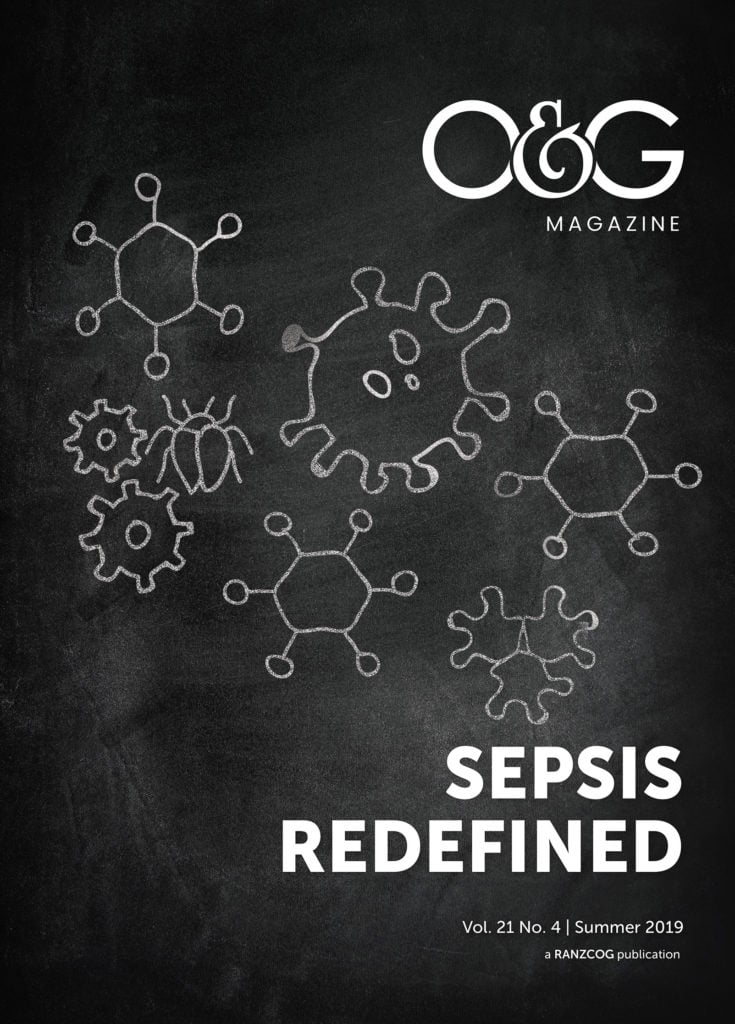Neonatal sepsis is one of the more feared conditions among paediatricians and neonatologists. It can be devastating; mortality for affected infants is high, especially if treatment is delayed. Worldwide, neonatal sepsis affects 3 million infants per year, of whom between 11–19 per cent do not survive.1 It is the third-highest cause of global neonatal mortality.2 This condition affects babies and their families in a multitude of ways: there is the stress of a neonatal intensive care unit admission, the impact of processing an unexpected diagnosis, and intensive medical therapy at a time otherwise expected to be spent bonding with a new family member. Further, for some survivors, neonatal sepsis has effects long beyond the newborn period as it increases the likelihood of developmental disability.3 4
Early-onset neonatal sepsis (EONS) refers to sepsis that presents in the first few hours/days of life, usually due to an organism acquired in the intrapartum period. In Australia, the frequency of EONS is estimated at 1.17/1000 livebirths.5 There are a suite of well-known maternal risk factors for EONS: chorioamnionitis, urinary tract infection, colonisation with Group B Streptococcus (GBS) and prolonged rupture of membrane time are some of the more commonly described of these6. For neonates, the most prominent risk factor is prematurity; both incidence and mortality from EONS increase with decreasing gestational age.7
Considering EONS: the first step of diagnosis
To diagnose sepsis, it first needs to be identified as a possibility. Thinking about whether a neonate could have EONS is a vital part of the evaluation process for any unwell newborn. However, identifying sepsis in neonates at an early stage is a challenging process. Early clinical signs of EONS can be subtle. They may be as simple as an infant who is quiet and breathing quickly or has become lethargic and lost their capacity to feed well. Further, they lack specificity; neonatal sepsis is aptly described as a ‘mimic’ of other pathologies. Evaluating whether maternal risk factors are present can add valuable information to the evaluation process. However, while these risk factors are well described, delineating how meaningful they are for an individual neonate is not straightforward. In broad terms, many more neonates are exposed to these risks than those who develop EONS. Further, in settings where widespread intrapartum antimicrobial prophylaxis occurs, the contribution of each of these to the risk of EONS has reduced in impact, at least for neonates who are born at, or close to, term.8 There are several diagnostic tests frequently used in the evaluation phase of neonatal sepsis. C-reactive protein and full blood examination are two of the more commonly described examples; however, neither of these has sufficient sensitivity to definitively rule out EONS at an early stage of illness.9 10 While blood cultures are a key diagnostic test for possible EONS11, their prolonged time to result means that they cannot direct early decision-making for whether a neonate requires treatment. Given this array of uncertainties in the evaluation process for EONS, the usual course of action is to commence empiric antimicrobial therapy at the point where neonatal sepsis is deemed possible, with re-evaluation of the need for this treatment later.
Guidance for identifying possible EONS
A variety of guidelines have been developed over the last several decades to assist clinicians that evaluate neonates for the possibility of EONS. These have largely been premised on identifying at-risk neonates through the presence of maternal risk factors, with a caveat that neonates with clinical signs of possible infection receive treatment regardless of maternal risk factor status.12 13 While guidelines such as these provide valuable structure to the identification process for EONS, they also direct clinicians to treat a number of babies who, with the benefit of hindsight, never had EONS.14 There is thus a situation of tension between clinicians and health services appropriately seeking to ensure that no treatment opportunities for EONS are missed, and the broader aim of limiting antimicrobial exposure in cases where, in retrospect, no antimicrobial treatment was needed. While our understanding of the longer-term effects of early life antimicrobial exposure is still evolving, potential links to later childhood morbidities, such as allergy, highlight the importance of consistently reappraising how antimicrobial use can be optimised among neonates.15 The development of tools to assist clinicians in safely reducing neonatal antimicrobial exposure for possible EONS has become the aim of a variety of research endeavours, with promising results. A successful example is the data-driven development and validation of the Kaiser Permanente Neonatal-Early Onset Sepsis Calculator, an online risk assessment tool that has now effected substantial reductions in antimicrobial use for possible EONS in a number of neonatal health services across the world.16
Confirming EONS: the second step of diagnosis
Moving beyond the initial stage where EONS is identified as a possibility, the next step is to finalise the diagnosis: determining whether the neonate really does have EONS. This is important for a number of reasons: a confirmed EONS diagnosis directs further therapy, such as duration and choice of antimicrobials, and in some cases may prompt additional investigations, such as lumbar puncture, to identify or exclude meningitis. For some neonates where a clear clinical illness is combined with microbiologic confirmation of infection, this is fairly simple. However, a number of infants have no identified pathogen, may have equivocal clinical signs, and the decision of whether they require a treatment and investigation course for EONS is then left to the discretion of their treating clinician.17 Determining how to discriminate which of these neonates require ongoing antimicrobial therapy is a topic of ongoing discussion and controversy among neonatologists.18 19
Moving towards consistency in definition
At present, there is no unified definition for neonatal sepsis (including EONS). In fact, multiple definitions for neonatal sepsis are in use across neonatal networks worldwide.20 This is in contrast to sepsis in the adult population, where operational consensus definitions are regularly reviewed and published.21 Efforts have now begun to better define neonatal sepsis for research22, and the need to develop a practical consensus definition for clinical use is now being actively discussed across neonatal sepsis literature.23 24 The overarching aim of these endeavours is to ensure neonatal sepsis diagnostic strategies become increasingly accurate so that treatment can be better targeted to cases with true EONS, where early treatment can be lifesaving. The way in which we identify and diagnose neonates with EONS will likely continue to be refined to achieve improved diagnostic certainty and consistency in the future.
Naomi’s PhD Program is supported by an Australian Government Research Training Program Scholarship.
References
- Fleischmann-Struzek C, Goldfarb DM, Schlattmann P, et al. The global burden of paediatric and neonatal sepsis: a systematic review. Lancet Respir Med. 2018;6(3):223-30.
- Lawn JE, Blencowe H, Oza S, et al. Every Newborn: progress, priorities, and potential beyond survival. Lancet. 2014;384(9938):189-205.
- Bakhuizen SE, de Haan TR, Teune MJ, et al. Meta-analysis shows that infants who have suffered neonatal sepsis face an increased risk of mortality and severe complications. Acta Paediatr. 2014;103(12):1211-8.
- Kohli-Lynch M, Russell NJ, Seale AC, et al. Neurodevelopmental Impairment in Children After Group B Streptococcal Disease Worldwide: Systematic Review and Meta-analyses. Clin Infect Dis. 2017;65:S190-S9.
- Singh T, Barnes EH, Isaacs D, et al. Early-onset neonatal infections in Australia and New Zealand, 2002—2012. Arch Dis Child Fetal Neonatal Ed. 2019;104(3):F248-F52.
- Shane AL, Sánchez PJ, Stoll BJ. Neonatal sepsis. Lancet. 2017;390(10104):1770-80.
- Shane AL, Sánchez PJ, Stoll BJ. Neonatal sepsis. Lancet. 2017;390(10104):1770-80.
- Puopolo KM, Draper D, Wi S, et al. Estimating the Probability of Neonatal Early-Onset Infection on the Basis of Maternal Risk Factors. Pediatrics. 2011;128(5):e1155-e63.
- Hornik CP, Benjamin DK, Becker KC, et al. Use of the Complete Blood Cell Count in Early-onset Neonatal Sepsis. Pediatr Infect Dis J. 2012;31(8):799-802.
- Eschborn S, Weitkamp JH. Procalcitonin versus C-reactive protein: review of kinetics and performance for diagnosis of neonatal sepsis. J Perinatol. 2019;39(7):893-903.
- Cantey JB, Baird SD. Ending the Culture of Culture-Negative Sepsis in the Neonatal ICU. Pediatrics. 2017;140(4).
- Verani J, McGee L & Schrag S. Prevention of Perinatal Group B Streptococcal Disease: Revised Guidelines from CDD, 2010. MMWR Recomm Rep. 2010;19(59):1-36.
- National Institute for Health and Care Excellence. Neonatal infection (early onset): antibiotics for prevention and treatment. 2012. Available from: www.nice.org.uk/guidance/cg149.
- Mukhopadhyay S, Taylor JA, Von Kohorn I, et al. Variation in Sepsis Evaluation Across a National Network of Nurseries. Pediatrics. 2017;139(3).
- Ahmadizar F, Vijverberg SJH, Arets HGM, et al. Early-life antibiotic exposure increases the risk of developing allergic symptoms later in life: a meta-analysis. Allergy. 2018;73(5):971-86.
- Achten NB, Klingenberg C, Benitz WE, et al. Association of Use of the Neonatal Early-Onset Sepsis Calculator With Reduction in Antibiotic Therapy and Safety. JAMA Pediatr. 2019. doi: 10.1001/jamapediatrics.2019.2825.
- Klingenberg C, Kornelisse RF, Buonocore G, et al. Culture-Negative Early-Onset Neonatal Sepsis — At the Crossroad Between Efficient Sepsis Care and Antimicrobial Stewardship. Frontiers in Pediatrics. 2018. doi: 10.3389/fped.2018.00285.
- Cantey JB, Baird SD. Ending the Culture of Culture-Negative Sepsis in the Neonatal ICU. Pediatrics. 2017;140(4).
- Klingenberg C, Kornelisse RF, Buonocore G, et al. Culture-Negative Early-Onset Neonatal Sepsis — At the Crossroad Between Efficient Sepsis Care and Antimicrobial Stewardship. Frontiers in Pediatrics. 2018. doi: 10.3389/fped.2018.00285.
- Vergnano S, Seale AC, Fitchett EJA, et al. Serious bacterial infections in neonates: improving reporting and case definitions. Int Health. 2017;9(3):148-55.
- Singer M, Deutschman CS, Seymour CW, et al. The Third International Consensus Definitions for Sepsis and Septic Shock (Sepsis-3). JAMA. 2016;315(8):801-10.
- Vergnano S, Buttery J, Cailes B, et al. Neonatal infections: Case definition and guidelines for data collection, analysis, and presentation of immunisation safety data. Vaccine. 2016;34(49):6038-46.
- Klingenberg C, Kornelisse RF, Buonocore G, et al. Culture-Negative Early-Onset Neonatal Sepsis — At the Crossroad Between Efficient Sepsis Care and Antimicrobial Stewardship. Frontiers in Pediatrics. 2018. doi: 10.3389/fped.2018.00285.
- Wynn JL, Wong HR, Shanley TP, et al. Time for a neonatal-specific consensus definition for sepsis. Pediatr Crit Care Med. 2014;15(6):523-8.






Leave a Reply